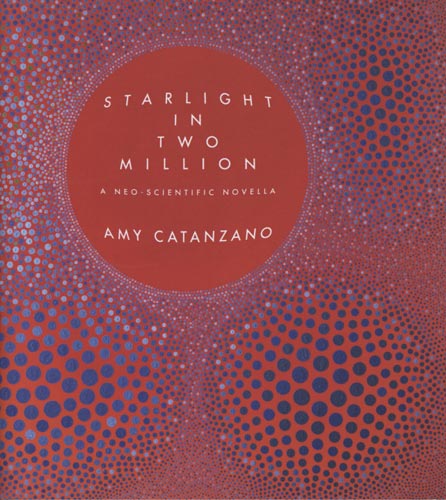Starlight in Two Million
Starlight In Two Million bills itself as a neo-scientific novella. Amy Catanzano works in quantum poetics, a lofty goal. She states that she tries to amplify the hallucinatory experience of the novel by changing perspectives and seeks to find a fourth person perspective in the mode of time. Detached and somewhat nonlinear, the novel moves from an outré perspective and gives itself to the form much of the time, posing a challenge for the reader looking for one. The work attempts to produce a feeling, a controlled navigation through a hypercube. Starlight In Two Million bills itself as a neo-scientific novella. Amy Catanzano works in quantum poetics, a lofty goal. She states that she tries to amplify the hallucinatory experience of the novel by changing perspectives and seeks to find a fourth person perspective in the mode of time. Detached and somewhat nonlinear, the novel moves from an outré perspective and gives itself to the form much of the time, posing a challenge for the reader looking for one. The work attempts to produce a feeling, a controlled navigation through a hypercube.
“The Becoming of Memory” begins with the line “How does anything shimmer beyond its borders?” This sets the trajectory of the work. The whole piece runs in a meta-tone of “How?” The question of How? is lost to the idea of what is beyond the borders. The borders of life itself. Foregoing overt questions of How?, the piece aims in multiple directions.
Starlight In Two Million is more concerned with philosophy than it is with fiction. Catanzano represents this with her Greek named characters, Aletheia—translated as truth by way of Heidegger—and Epoche—a term meaning “the suspension of belief in the real world.” These characters seem to intertwine as synonyms and antonyms alternatingly. The beginning sets the pace as the two correspond to one another. “Two Acts” has Epoche writing Aletheia:
One by one, fireflies burn as if performing acts of self-worship. The river in
late spring seizes its own urgency. Each leaf falls from the favor of its tree. On
the hour, leaves gather on the ground, signaling the end of Act I.
The first thing to be noticed when the words are isolated from the text is that fact that one is reading a poem. These are the observations incurred from one suspending belief in reality during wartime. Catanzano has created a universe, or a multiverse as she would put it. The above lines of the poem are written to Aletheia and she responds in “Wavelengths” with one simple line, “I wonder that, too, if every light we see is a star.” This keeps the narrative moving forward. There is a war happening that the two must fight to keep from taking everything good.
The good is established as Temporary Autonomous Zones. Catanzano states that TAZ are a place where the poetic imagination is free to reign. This whole book moves inside of her own constructed TAZ. She creates rules inside of her novella that she adheres to and wishes for you to figure out along with her characters. “Temporary autonomous zones—TAZ as they are affectionately called—are forged rather than entered.”
The poem then uses the meta method of describing through question:
Additional poems will be played in TAZ.
Will the player be played backward?
Will the player enter the fortress equipped with money or fantasy?
Will hungry avatars use the players to intervene in the doctrine?
Is there a feasible, yet risky, rescue plan?
Can repositioning the poem solve the puzzle?
Rules ask even more of the players they compute.
The war is being fought with poetry. It is being fought with the philosophical method, through questions. The above shows that the very rules that this piece creates are the fun and joy that the universe provides to the living. As time moves forward, Starlight In Two Million shifts perspectives under the guise of narrative and creeps into the brain of the reader. It is almost subliminal in nature.
The book is difficult and inaccessible at times, just like a true piece of philosophy. In art’s attempt to create the new form of communication, this piece tries to reassemble reality in a completely accurate manner, the manner of the 4th perspective, that of God. As Catanzano would seek to describe through question, a proper response to this book may be a question as well: Can we really read books from the timeless perspective of God?





